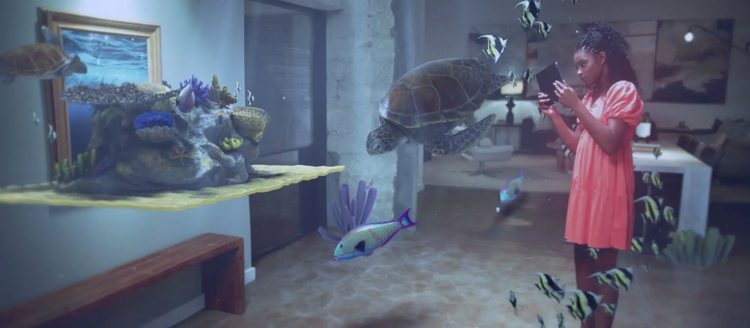Adobe and the metaverse: the future of immersive

Image credit: Adobe Stock / Jakub
The metaverse may sound like the working title for a new Marvel movie but make no mistake: it’s real and in many ways it’s already here. Augmented reality shopping, virtual travel in 3D, in-game live concerts, immersive company websites — all these experiences exist today and will only become more compelling as brands get better at creating hyper-realistic digital worlds.
For all the headlines the metaverse is getting, it’s not out-of-reach to everyday brands and our customers. Rather, we’re at an inflection point where the right technology and a voracious appetite for immersive experiences are starting to shift our current business reality.
The big move to the metaverse is something that everybody can — and should — take part in.
What is the metaverse?
The metaverse — that is: immersive, always-on digital spaces rich in connected, personal experiences — is poised to be the future of digital interaction. We believe brands need to prepare now to make the most of the many opportunities the metaverse presents, such as immersive customer experiences, commerce, and efficiencies in internal business processes.
And, as more companies begin to build out the metaverse ecosystem, we also believe it’s crucial to set industry standards to create a fair and open digital platform where all brands and customers can participate. Adobe has championed open standards and open access in our decades of creating era-defining technology. We continue to stand behind our values as we build the tools that are building the metaverse.
We envision an open, accessible, and safe metaverse. And as a company with one foot already there, we aim to help other businesses succeed in the metaverse.
Finding your place in the metaverse
In many ways, the metaverse could be considered the next evolution of the internet. When the initial e-commerce boom changed the business landscape, stragglers got left behind. With the metaverse, businesses have the chance to prepare ahead of time and make the most of every new opportunity.
Let’s start with a caveat: we believe there won’t be just one metaverse — there will be many, plus other kinds of immersive experiences as well. Always-on digital experiences where people interact with digital objects, digital environments, and each other. It can be Virtual Reality (VR), where people put on a headset and enter a completely digital 3D world. And it can be Augmented Reality (AR), where our real-life world is enhanced with a digital experience, often via our smartphones, through visual, sounds, or even haptics.
The metaverse in action
While nothing’s going to replace the physical world, the metaverse included, there’s an increasing number of things people can do in digital environments that used to be done offline.
The Smithsonian Institution, for example, used Adobe Aero to create AR 3D Coral Reef exhibitions, an a remote learning experience for students to learn about the threats facing ocean ecosystems.

As for fully immersive, one of the quintessential metaverse experiences today is Fortnite, especially when played on a VR headset.
Created by Epic Games in 2017, Fortnite has become arguably the most-popular co-op video game on the planet. More impressively, Epic has created a virtual community of users that live, socialize, and engage with the world through the game, whether they’re attending a VR Ariana Grande concert or banding together to raise more than $50 million in humanitarian relief funds to help people affected by the war in Ukraine.
At Adobe Summit in March, Marc Petit, vice president of the Unreal Engine Ecosystem at Epic Games, neatly summed up the potential of immersive worlds as an engagement platform. “Whether you’re a game developer, architect or automotive designer, today’s consumers expect truly immersive interactive experiences,” he says.
Petit also explained how his company is not only working with us to generate new audiences, but to inspire creators. “Together with Adobe, we’re developing new tools that empower creators to build real-time 3D experiences that push the boundaries of photorealistic immersion.”
Core to the metaverse: 3D
Whether or not you expect to dive fully into the metaverse, you can bet that it will change certain aspects of how you do business. The 3D technology that exists today will, in many ways, be the backbone of tomorrow’s immersive experiences. Companies are already using 3D tools to gain big efficiencies in their current businesses — and these brands will be ahead of the game once the metaverse becomes widespread.
At Adobe Summit, we revealed how we’re collaborating with brands such as The Coca-Cola Company, Epic Games, NASCAR and NVIDIA on 3D content creation, e-commerce and portable immersive experiences.
As Scott Belsky, our chief product officer for Creative Cloud, said: “One thing that’s been true about every new medium is that it succeeds or fails based on the nature of the content that fills it.” In other words, success in the metaverse will depend on a brand’s ability to create engaging 3D experiences that resonate with their customers and community.
By getting started with 3D design today, companies can build an enduring catalog of digital products and assets that will serve as a foundation for their immersive experiences for years to come. What’s more, virtual purchases and design will give brands more space than ever to share their personalities and sensibilities with customers.
Immersive customer experiences, digital asset sales, metaverse marketing, and more will all require 3D and AR expertise. Building these capabilities now could save you frustration — and help your bottom line — tomorrow.
Customer experience matters in the metaverse
If the internet is any indication of how the metaverse will change the future of business, the metaverse is set to be the newest and most important marketing channel. All the gorgeous, mind-bending 3D assets and AR experiences that companies are creating need to be able to find their way into the metaverse — and to every individual customer — at scale. We’ve spent years helping companies deliver customer experiences across all the current channels, and the metaverse next.
Today’s immersive experiences are largely built using our industry-leading 3D and immersive content creation tools, Substance 3D and Aero. Smart brands are using 3D design workflows, such as virtual photography with tools like Substance Stager, to not only make amazing experiences for customers, but to make their product design and marketing content production better, faster and more efficient. Using these tools for today’s workflows isn’t just critical for success today, it’s also getting these brands metaverse-ready for future customers.
In the new metaverse economy, we expect to see digital commerce grow exponentially. Customers want digital possessions, clothing, artwork, avatars, and even real estate. Buying, selling and trading these items will happen with the support of Adobe Experience Cloud, including Adobe Commerce capabilities.
To connect with audiences in the metaverse, companies can use Adobe Experience Manager to store and deliver personal experiences for any type of digital media, including 3D and AR. Experience Manager is the leading experience delivery and asset management solution for all types of digital media, and it will evolve to be the center point of asset delivery and asset management for all types of digital media.
Combined with Adobe Workfront, companies will be able to manage every aspect of the experience delivery process within a single unified system that can scale across and within every type of digital channel.
In short, we have the tools to build and deliver amazing metaverse experiences — and we’re excited to lead the way to the metaverse with our cutting-edge technology and time-proven values.
Setting standards in the metaverse
For the past 40 years, we have been changing the world through digital experiences — and setting a high bar for how we believe the digital world should operate. We invented desktop publishing with PostScript, revolutionized imaging and artistic expression with Photoshop, and shifted the way the world handles documents with PDF.
There’s a thread that ties all these changes together: making the digital world something that everyone can participate in and benefit from.
We see the metaverse as a natural evolution of our mission, and we believe it is important to have a safe, accessible, and open metaverse.
- We support open standards and platforms, because brands, creators, and designers should be able to create an asset one time and distribute it everywhere for people to enjoy.
- 3D creativity should be accessible to all. Adobe is committed to providing 3D and immersive creativity tools that allow anyone to express their point of view in the metaverse and other shared immersive worlds. Just as importantly, we want to empower people from all backgrounds to collaborate and create enriching content together.
- We believe in the transparency of virtual creativity, including how immersive assets were developed. The market for virtual creations represents an important new way for artists to profit from their work and for consumers to support creators they admire. The only way that market can thrive is if people can trust the provenance of the assets they buy. Adobe’s work with the Content Authenticity Initiative is all about shedding light on how virtual creations are made and ensuring the artists who made them get the credit they deserve.
- We help creators, communicators, solopreneurs, and businesses of all sizes leverage immersive experiences. Adobe is in the business of helping brands thrive, and that means providing them with the tools and support they need to take full advantage of virtual experiences and commerce.
Getting started with the metaverse
As Gavin Miller, vice president, fellow and head of Adobe research, says: “Our fundamental value proposition is liberating people’s creative imaginations, and as the canvases evolve, we’ll evolve with them.”
In that spirit, Adobe has created a Metaverse reference site and playbook to help agencies, brands, and creators fast-track their understanding of experience design and customer engagement in an immersive environment. We are committed to exploring this new and exciting technology alongside our partners and customers.
Nobody can predict exactly what the Metaverse will bring, but you can prepare yourself and your company by building a strong foundation of knowledge and technologies that will help your business to navigate change and unlock the immense opportunities ahead.